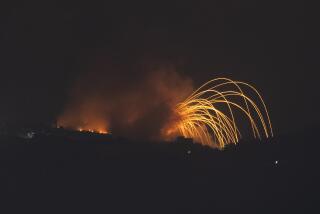News Background : Rival Political, Religious Factions May Exceed 100
- Share via
The number of rival political and religious elements in Lebanon is thought to exceed 100, with new splinters and fragments emerging and loyalties shifting all the time. Many have a militia, or military arm.
The primary division is religious, Muslims on the one hand and Christians on the other. The Muslims account for somewhat more than half the population, which is estimated at 3.5 million. Until the outbreak of civil war, in the mid-1970s, government offices were shared more or less equally by Christians and Muslims.
Currently, most of the fighting around Beirut is between two Muslim factions, the Sunni Muslim-dominated Palestine Liberation Organization and the Shia Muslim militia known as Amal.
The more important factions:
Shia Muslims--The Shias, many of whom are followers of Iran’s Ayatollah Ruhollah Khomeini, dominate southern Lebanon. Their military arm is the Amal, founded in 1974 by the Imam Moussa Sadr, Iranian-born spiritual leader of the Shias. Today, Amal is led by Nabih Berri, a lawyer with close ties to Syria, which reportedly supplies some of its arms. Before Israel invaded Lebanon in 1982, Amal fought the PLO for control of villages in southern Lebanon and for control of West Beirut, but then fought alongside the Palestinians against the Israelis. Now the Amal is trying to drive the PLO out of Beirut’s Palestinian refugee camps. Palestine Liberation Organization--The PLO, which has been led for years by Yasser Arafat, was formed after Israeli independence in 1948, with the goal of destroying Israel and recovering the Palestinian homeland. The PLO was forced out of Beirut in 1982 by the invading Israeli army. But many Palestinians who left the country then or who withdrew to Syrian-dominated areas in the north and east, have infiltrated back into the Beirut area.
A large pro-Syrian faction has broken away from the PLO in a dispute over Arafat’s tactics. Although the two PLO sides have fought, especially around the northern Lebanese city of Tripoli, they are reported to be cooperating in the current battle against Amal. PLO fighting strength is not clear, for its elements are scattered.
Sunni Muslims--The Sunnis--a majority in the Islamic world but a minority in Lebanon--have a militia headquartered in Beirut. Called the Mourabitoun, it has had as many as 1,000 armed men in Lebanon. But the Mourabitoun has not been able to assert itself to any appreciable degree recently. Its numbers have been reduced sharply by the factional fighting.
Christians--Lebanese Christians, who number about 1.5 million, dominate the shaky national government and control the eastern part of divided Beirut. Their leader is President Amin Gemayel. Christians are not directly involved in the present fighting at the refugee camps, but they are a major factor in the fighting raging across the so-called Green Line that separates the eastern and western sectors of the capital and in the fighting in the south of Lebanon, in areas that had been occupied until recently by Israeli troops.
Druze--This highly secretive sect--an offshoot of Islam--controls a large section of the Shouf mountains just east and south of Beirut. It maintains its own well-armed militia and continues to be a military factor in Beirut and the Shouf.
More to Read
Sign up for Essential California
The most important California stories and recommendations in your inbox every morning.
You may occasionally receive promotional content from the Los Angeles Times.










